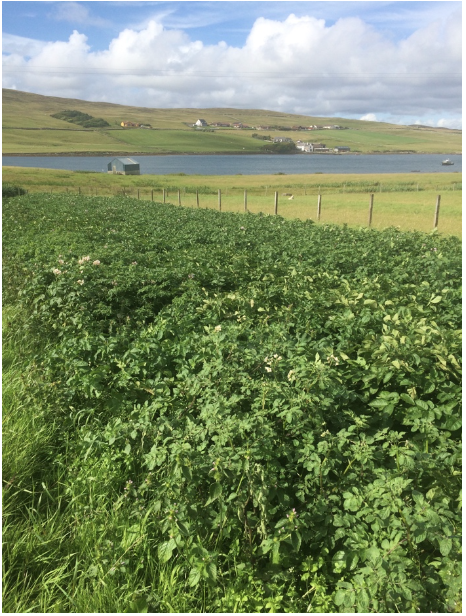Crop: Solanum tuberosum L. (Potato)
Shetland black potatoes originate from the Shetland Islands in Scotland. Potato varieties are numerous, with variation in colour and size attributes abundant. The Shetland black cultivar has purple-blue skin with yellow flesh. They have a distinctive purple ting in the flesh. The tubers are oval in shape, small to medium in size, and are fairly uniform (Europotato.org, 2019).
Many growers of this variety on the Scottish Islands of Shetland and Orkney do so in very small amounts. They are either used for personal consumption, shared with friends and family, or occasionally sold locally.
Cultivation System: ND.
Geographical Information
Country: United Kingdom
This cultivar is grown on Shetland and Orkney in small quantities. It is also available to buy online so it is likely grown in many areas of the UK in garden settings.
Farmer(s) description:
This landrace is commonly grown in small areas in gardens. The rooting system is shallow allowing them to be grown in a container if desired, or alternatively in the ground. While commercial harvests are done with large potato harvesters, those growing this landrace predominantly do so in small amounts in their gardens and harvest by hand or by using a spading fork. Once harvested potatoes are dried, cooled, and stored in a dark space ideally at temperatures between 7-10° to prevent rotting (Crosstree.info, 2019).
The main constraint facing most growers of this potato landrace is late blight, caused by Phytophthora infestans. This is an issue which is growing as Phytophthora infestans becomes more aggressive and resistance to using environmentally damaging chemicals to control it increases among the general public (Haverkort et al., 2008).
Propagation system: Clonal
Multiplication procedures and consequences on landrace diversity:Potatoes are grown from seed potatoes which are tubers bred to be free from disease and grow to give a potato crop. They use vegetative reproduction with sprouts growing from eyes of the potato and giving rise to new plants and propagate the genotype clonally (Singh and Kaur, 2009). This can occur from a cutting of a tuber or seed tuber. With Shetland black potatoes the parent material is sometimes sourced online, or may be bought, swapped, or gifted between growers of this landrace on the Scottish Islands. Swapping and sharing between growers is most beneficial to maintaining the gene pool.
Shetland black seed potatoes are widely available online from several heritage potato websites. This means that it can be bought and grown in any area of the UK which may lead to a loss of the local adaptations associated with Shetland black. The reproduction methods of potatoes, however, do not allow for adaptations or evolution to occur as frequently as plants which reproduce sexually. This means that potatoes are at lower risk of losing local adaptations than, for example, a barley landrace and any losses will occur over a longer time period.
Management plan existence:The landrace management relies heavily on maintaining farming activities in Shetland as this is where Shetland black potatoes originated from. Cultivation elsewhere may lead to the loss of local adaptations associated with this landrace and the development of new ones.
Added Values
Many maintainers of this landrace on Shetland and Orkney do not market their potato crops. They are often for personal consumption or to be shared with friends and family but are occasionally sold at local markets or informally to acquaintances.
This is not to say that there is no wider market for the Shetland Black potato. They are available to buy online where their status as a registered ‘Slow Food’ is a selling point (Heritage-potatoes.co.uk, 2019).
Others (e.g. commercial/geographical brands or special traits):Shetland black potatoes have caught the attention of the ‘Slow Food’ movement in the UK and are therefore now a registered Slow food (Slow Food in the UK, 2019). Potato landraces fall under SASA’s Scottish Landrace Protection Scheme (Sasa.gov.uk, 2019).
Shetland black potatoes are protected under SASA’s Scottish Landrace Protection Scheme (Sasa.gov.uk, 2019). SASA maintains the largest gene bank collection of potato varieties in the UK, but they are not currently included in the vegetable landrace inventory (Kell at al., 2009). Information on Shetland black potatoes can be found online in the European Cultivated Potato Database which is maintained by SASA (Europotato.org, 2019.
Work by Peter Martin and those at Orkney College UHI has increased the commercial value of the landrace and contributed to the renewal of interest in bere on the islands, giving hope for future conservation of this landrace.
Maintained interest in Shetland black potato due to the slow food movement could see hope for the future of on-farm conservation efforts.
Uncertain. For more information or for access to this resource, SASA should be contacted.
Case study provided by University of Birmingham, United Kingdom.
- Assets.publishing.service.gov.uk. (2019). [online] Available at: https://assets.publishing.service.gov.uk/government/uploads/system/uploads/attachment_data/file/747210/structure-jun2018prov-UK-11oct18.pdf [Accessed 27 Nov. 2019].
- Crosstree.info. (2019). [online] Available at: http://www.crosstree.info/Documents/POTATO%20STORAGE.pdf [Accessed 28 Nov. 2019].
- Europotato.org. (2019). Varieties. [online] Available at: www.europotato.org/varieties/view/Shetland%20Black-E [Accessed 27 Nov. 2019].
- Haverkort, A., Boonekamp, P., Hutten, R., Jacobsen, E., Lotz, L., Kessel, G., Visser, R. and van der Vossen, E. (2008). Societal Costs of Late Blight in Potato and Prospects of Durable Resistance Through Cisgenic Modification. Potato Research, 51(1), pp.47-57.
- Heritage-potatoes.co.uk. (2019). Shetland Black 1923 | Purple Potatoes | Carroll's Heritage Potatoes. [online] Available at: https://heritage-potatoes.co.uk/product/shetland-black-1923/ [Accessed 3 Dec. 2019].
- Kell, S.P., Maxted, N., Allender, C., Astley, D., Ford‐Lloyd, B.V. and contributors (2009) Vegetable Landrace Inventory of England and Wales. The University of Birmingham, UK. 117 pp.Sasa.gov.uk. (2019). Scottish Landrace Protection Scheme (SLPS) | SASA (Science & Advice for Scottish Agriculture). [online] Available at:https://heritage-potatoes.co.uk/product/shetland-black-1923/ [Accessed 27 Nov. 2019].
- Singh, J. and Kaur, L. (2009). Advances in potato chemistry and technology. Dundee: Academic Press, pp.1-26.
- Slow Food in the UK. (2019). Shetland Black Potato - Slow Food in the UK. [online] Available at: https://www.slowfood.org.uk/ff-products/shetland-black-potato/ [Accessed 12 Dec. 2019].
